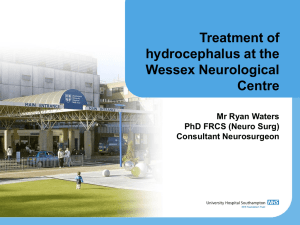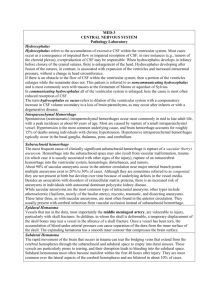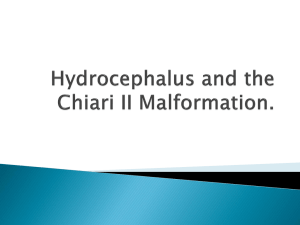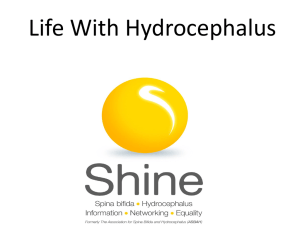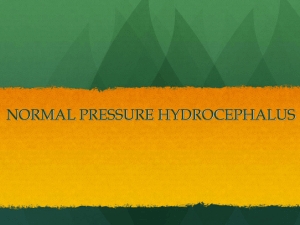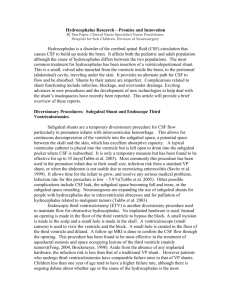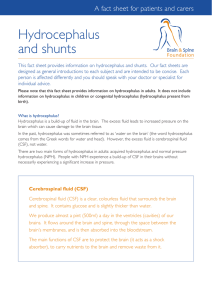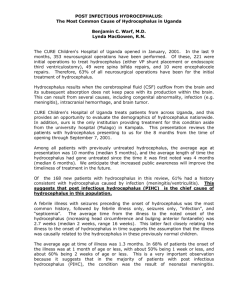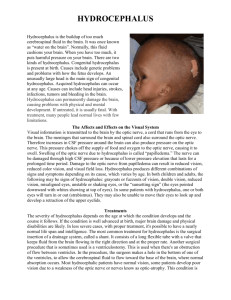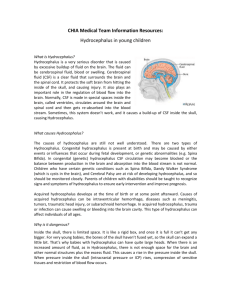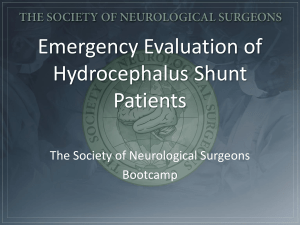- Neurosurgery Research Listserv
advertisement
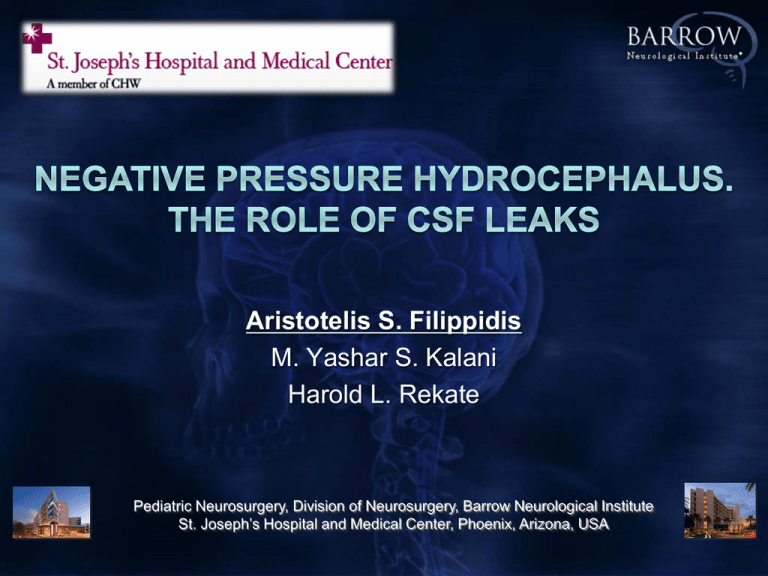
Aristotelis S. Filippidis M. Yashar S. Kalani Harold L. Rekate Pediatric Neurosurgery, Division of Neurosurgery, Barrow Neurological Institute St. Joseph’s Hospital and Medical Center, Phoenix, Arizona, USA • HPI: A 61 yo patient presented, lethargic and dragging his left foot in the emergency room. Symptoms of hydrocephalus were present. • PMH: clipped ruptured PICA aneurysm complicated by posthemorrhagic hydrocephalus, meningitis and a CSF leak. The patient needed multiple shunts revisions that failed repeatedly in the past. • IMAGING ventriculomegaly demonstrated on CT was present at the time and we thought that the patient had hydrocephalus due to a failed a shunt. • SHUNT REVISION • But the patient did NOT IMPROVE. • WHY ??? • NO proof of proximal or distal obstruction of the shunt • NO proof of mechanical shunt malfunction • Negative pressure measured at the ventricular level • Radionuclide studies and iohexol cisternogram demonstrated a block between the ventricular level and subarachnoid space (SAS) DEFINITION • Ventriculomegaly • Verified Negative pressure measurement with ICP probe At the ventricular compartment • Signs and symptoms of hydrocephalus THE USUAL CONTEXT: • Posthemorrhagic or postinfection hydrocephalus • Disconnection between subarachnoid space (SAS) and ventricular compartment • Presence of a cerebrospinal (CSF) leak • Presence of a failing shunt • A LEAK at the subarachnoid space lowering the pressure in this CSF compartment • A BLOCKAGE at the connection between the ventricles and the subarachnoid space (remember hemorrhage in SAS and meningitis in patient’s PMH) • A MODIFICATION of the brain’s ability to resist distortion due to applied forces (modified brain turgor) • A GRADIENT in the transmantle pressure (pressure at the brain surface) is created, the subarachnoid space acts as a VACUUM, the ventricles expand and the shunt is not working due VENTpressure well below threshold • A NEW EQUILIBRIUM is established. INITIAL EQUILIBRIUM Transmantle pressure = PVENTS – PSAS > cause PVENTS > PSAS BRAIN Vents Transi t SAS LEAK 0 Transmantle pressure = PVENTS – PSAS = NEW EQUILIBRIUM ESTABLISHED Stable rate of CSF production and loss Vents bigger SAS smaller Transmantle pressure ZERO 0 • SEAL the CSF Leak Reoperation with a watertight closure • Establish Ventricular-Subarachnoid space COMMUNICATION Lysis of fibrosis in SAS or ETV in select cases • INCREASE the pressure in SAS Neck wrapping as a conservative treatment • RESTORE modified brain turgor EVDs for few days set to subzero pressure • • • • Compression of the jugular veins Increases pressure in jugular system Increases pressure in Superior Sagittal Sinus CSF absorption from the arachnoid granulations decreases so the pressure in the SAS increases. • Increases brain turgor. Makes brain stiffer. • Ventriculomegaly and HCP symptoms REVERSE transiently! a. WITHOUT neck wrapping, b. WITH neck wrapping, c. Neck wrapping REMOVED So what is BRAIN TURGOR ? • It is the ability of the brain to RESIST DISTORSION • Brain turgor = 0 means a soft brain that can’t resist distorsion, so changes in intracranial volume DO NOT increase ICP, brain distorts and acts like a sponge • Brain turgor = 1 means a stiff brain, highly resistant to distorsion, so changes in intracranial volume DO increase ICP, brain cannot act like a sponge In Negative pressure HCP the brain turgor is LOW due to loss of venous blood or extracellular fluid • Prolonged EVDs to subzero ICP restore the ability of the brain to find its previous form. Brain recoils to its previous state but this needs time. (find opening pressure, lower 2-4cm/d, identify vent shrinkage with CT, maintain the level for few days and then raise EVD till restoration of brain turgor) • Part of the lost Venous blood comes back to brain and restores its brain turgor. • A ventriculoatrial shunt set at 30mm H2O was placed • The patient recovered well with resolution of the symptoms of hydrocephalus and ventriculomegaly Bannister. A report of eight patients with low pressure hydrocephalus treated by C.S.F. diversion with disappointing results. Acta neurochirurgica (1972) vol. 27 (1) pp. 11-5 Clarke et al. Very low pressure hydrocephalus. Report of two cases. J Neurosurg (2006) vol. 105 (3) pp. 475-8 Dias et al. Low-pressure shunt 'malfunction' following lumbar puncture in children with shunted obstructive hydrocephalus. Pediatric neurosurgery (1999) vol. 30 (3) pp. 146-50 Lesniak et al. Low pressure hydrocephalus and ventriculomegaly: hysteresis, non-linear dynamics, and the benefits of CSF diversion. Br J Neurosurg (2002) vol. 16 (6) pp. 555-61 McCullough and Fox. Negative intracranial pressure hydrocephalus in adults with shunts and its relationship to the production of subdural hematoma. J Neurosurg (1974) vol. 40 (3) pp. 372-5 Owler et al. Low pressure hydrocephalus: issues of diagnosis and treatment in five cases. Br J Neurosurg (2001) vol. 15 (4) pp. 353-9 Pang and Altschuler. Low-pressure hydrocephalic state and viscoelastic alterations in the brain. Neurosurgery (1994) vol. 35 (4) pp. 643-55; discussion 655-6 Rekate et al. The importance of the cortical subarachnoid space in understanding hydrocephalus. Journal of neurosurgery Pediatrics (2008) vol. 2 (1) pp. 1-11 Rekate. The definition and classification of hydrocephalus: a personal recommendation to stimulate debate. Cerebrospinal fluid research (2008) vol. 5 pp. 2 Rekate. Brain turgor (Kb): intrinsic property of the brain to resist distortion. Pediatric neurosurgery (1992) vol. 18 (5-6) pp. 257-62 Singounas et al. Observations on the pathogenesis of low pressure hydrocephalus. Analysis of 25 cases. Neurochirurgia (1976) vol. 19 (1) pp. 22-5 Vassilyadi et al. Negative-pressure hydrocephalus. J Neurosurg (1995) vol. 83 (3) pp. 486-90
